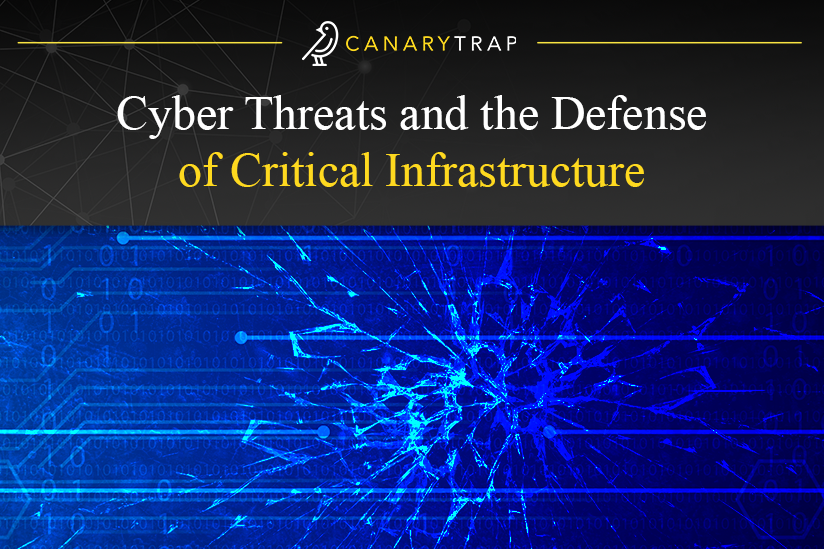Cyber Threats and the Defense of Critical Infrastructure
- March 22, 2024
- Canary Trap
In an era defined by technological advancement and digital interconnectivity, critical infrastructure stands as the linchpin of modern societies. From power grids and transportation systems to healthcare institutions and financial networks, these sectors form the foundation upon which nations build their prosperity and resilience. However, the same interconnectedness that fuels progress also exposes critical infrastructure to unprecedented cyber threats, posing a formidable challenge to its security and stability.
In this blog, we seek to illuminate the intricate landscape where the digital realm intersects with the physical infrastructure that sustains our way of life. As societies embrace smart technologies, the vulnerabilities of critical infrastructure become more pronounced, inviting a spectrum of cyber threats that range from ransomware attacks to sophisticated state-sponsored intrusions. The consequences of a successful cyber attack on these vital sectors extend far beyond the digital realm, potentially compromising public safety, economic stability, and even national security.
Against this backdrop, the need to protect critical infrastructure from cyber threats emerges as a top priority. Let’s embark upon a comprehensive exploration, navigating the challenges, consequences, and proactive measures essential for fortifying the digital defenses of critical infrastructure.
Understanding Critical Infrastructure
Critical infrastructure forms the backbone of societies, encompassing a diverse array of sectors which are vital for national security, economic stability, and public well-being. By gaining a comprehensive understanding of critical infrastructure, we lay the groundwork for effective cybersecurity measures tailored to the unique challenges posed by these essential sectors.
- Definition and Scope
Critical infrastructure refers to the foundational assets, systems, and networks that, if compromised, could have debilitating effects on a nation’s security, economy, or public health. This includes but is not limited to energy, transportation, water supply, healthcare, and communication systems. The interdependence of these sectors creates a complex web that demands specialized attention to cybersecurity.
According to the United Nations University, “Critical infrastructures are generally understood as facilities and services vital to the basic operations of a society. Sectors that are considered as ‘critical infrastructure’ vary among different countries, but most would comprise: energy, water, food, transport, telecommunications, healthcare, as well as banking and finance. However there is no universally agreed definition in place – each country defines it based on national priorities.”
- Sectors Encompassed
The scope of critical infrastructure is broad and encompasses various sectors, each playing a crucial role in the functioning of a nation. Energy infrastructure, including power grids and fuel supply, is vital for sustaining modern life. Transportation systems, such as railways and airports, facilitate the movement of goods and people. Water supply and treatment ensure public health, while healthcare systems safeguard well-being. Communication networks and financial institutions are integral components as well, supporting the seamless flow of information and economic transactions.
As we navigate the landscape of critical infrastructure, it becomes evident that the sectors involved are interconnected, creating an intricate tapestry of dependencies. The inherent importance of these sectors makes them attractive targets for cyber threats, which means a proactive and adaptive approach to cybersecurity are needed.
Cyber Threats to Critical Infrastructure
The digital age has ushered in unprecedented connectivity, efficiency, and innovation, but it has also exposed critical infrastructure to an escalating array of cyber threats. Understanding these threats is paramount for devising effective cybersecurity strategies tailored to the unique challenges faced by essential sectors.
As stated on the website of Homeland Security for the United States, “Cybersecurity threats to critical infrastructure are one of the most significant strategic risks, […] threatening our national security, economic prosperity, and public health and safety. In particular, nation-states are targeting critical infrastructure to collect information and gain access to industrial control systems in the energy, nuclear, water, aviation, and critical manufacturing sectors. Additionally, sophisticated nation-state attacks against government and private-sector organizations, critical infrastructure providers, and Internet service providers support espionage, extract intellectual property, maintain persistent access on networks, and potentially lay a foundation for future offensive operations.”
- Types of Cyber Threats
Critical infrastructure is susceptible to a wide range of cyber threats, each posing distinct risks. Cyberattacks can manifest as ransomware, where attackers encrypt systems and demand payment for their release, disrupting operations and potentially causing widespread harm.
Advanced Persistent Threats (APTs) involve stealthy, long-term infiltration by sophisticated adversaries aiming to compromise infrastructure integrity, while Distributed Denial of Service (DDoS) attacks aim to overwhelm networks, leading to service disruptions. Additionally, the Internet of Things (IoT) introduces new vulnerabilities, as interconnected devices provide potential entry points for malicious actors.
- Impact of Cyber Threats
The consequences of successful cyberattacks on critical infrastructure can be severe and far-reaching. Disruptions to the energy sector can lead to power outages, impacting entire communities and critical services. Transportation systems may face disruptions, affecting the movement of goods and people. Cyber intrusions in healthcare can compromise patient data and disrupt medical services. Financial institutions, a linchpin of the economy, are vulnerable to attacks that could undermine economic stability. The interconnected nature of critical infrastructure magnifies the ripple effects, emphasizing the need for robust cybersecurity measures.
Just so we understand the volume of cyber attacks we are referring to, let’s take a look at 2023’s data gathered by Security Today: “In the last year, the world’s critical infrastructure – the medical, power, communications, waste, manufacturing, and transportation equipment that connects people and machines – has been under near-constant attack. Forescout Research – Vedere Labs recorded more than 420 million attacks between January and December 2023. That is 13 attacks per second, a 30% increase from 2022.”
Cybersecurity Challenges in Safeguarding Critical Infrastructure
While the importance of securing critical infrastructure is undeniable, achieving effective cybersecurity in these complex sectors poses unique challenges, which should be recognized and addressed in order to fortify the resilience of critical infrastructure against evolving threats.
As discussed in an article by Issues.org: “In an open society, higher fences and thicker walls do little to reduce aggregate vulnerabilities. In many instances, protection simply shifts the focus of terrorists to other, less heavily fortified targets. […] What is being protected is not the infrastructure itself but the services it provides.” It was also mentioned that: “The policy goal should be to build capabilities for prevention of attacks that interrupt such services and for effective response and rapid recovery when such attacks do occur.”
This emphasizes the complexity of protecting critical infrastructure, and the importance of focusing on the continuity of services, and creating rapid response to address the dynamic nature of these threats.
- Interconnectedness and Complexity
Critical infrastructure sectors are interconnected, relying on shared technologies and networks. This interconnectedness amplifies the potential impact of cyber threats, as a breach in one sector can cascade into others. The complexity of these systems, often characterized by legacy technologies and diverse components, complicates cybersecurity efforts. Therefore, safeguarding critical infrastructure requires a nuanced understanding of these interdependencies and intricate systems.
- Resource Constraints
Many entities within critical infrastructure sectors operate with limited resources, making it challenging to allocate sufficient funds and personnel for robust cybersecurity measures. Small to medium-sized enterprises, which play significant roles in critical infrastructure, may lack the financial means to invest in advanced cybersecurity technologies. Addressing resource constraints necessitates innovative solutions and collaborative efforts to ensure comprehensive cybersecurity across the entire critical infrastructure landscape.
- Regulatory Compliance and Standards
Critical infrastructure sectors are subject to diverse regulations and standards, each with its own set of cybersecurity requirements. Navigating this regulatory landscape can be complex, requiring organizations to adhere to multiple frameworks simultaneously. Striking a balance between compliance and proactive cybersecurity measures is crucial, as adherence to regulations alone may not guarantee resilience against sophisticated cyber threats.
The multifaceted nature of critical infrastructure cybersecurity presents significant hurdles. As we delve into specific challenges, it becomes evident that resilience requires a comprehensive and tailored approach.
Key Cybersecurity Measures
Safeguarding critical infrastructure demands a comprehensive and proactive cybersecurity strategy that extends beyond conventional security practices. In the realm of key cybersecurity measures, organizations must prioritize advanced technologies tailored to combat modern threats. Proactive defense involves the implementation of cutting-edge solutions such as intrusion detection systems, anomaly detection, and robust encryption protocols. These measures act as an essential bulwark against evolving cyber threats that target critical infrastructure.
Moreover, regular cybersecurity assessments and audits are imperative. These evaluations ensure that protective measures remain aligned with the dynamic threat landscape. As technology evolves, so do potential vulnerabilities. Hence, routine evaluations become a cornerstone for fortifying critical infrastructure against emerging cyber risks.
However, effective cybersecurity is not solely contingent on technological solutions. People are a crucial element in the defense against cyber threats. That’s why training and awareness programs play a pivotal role in creating a cybersecurity-conscious workforce. From basic cyber hygiene to recognizing sophisticated social engineering tactics, an informed and vigilant workforce serves as the primary line of defense.
In essence, achieving robust cybersecurity for critical infrastructure requires a holistic approach that combines advanced technology, regular assessments, and a well-informed workforce. This multifaceted strategy is vital for mitigating risks, ensuring resilience, and maintaining the integrity of critical systems.
In Conclusion
In the ever-evolving landscape of cybersecurity, protecting critical infrastructure stands as a paramount challenge. As technology advances, so do the tactics of cyber threats, necessitating a multifaceted approach to defense. Proactive cybersecurity measures, such as advanced threat detection, regular vulnerability assessments, and robust incident response plans, form the backbone of a resilient defense system. By integrating these measures, organizations can create a dynamic security posture that adapts to emerging threats.
The importance of securing critical infrastructure in the digital era cannot be overstated. It requires constant vigilance, investment in cutting-edge technologies, and a proactive mindset that anticipates and addresses potential threats. By embracing these principles and fostering collaboration across sectors, we can create a robust cybersecurity ecosystem that safeguards critical infrastructure, ensuring the stability and security of our digital society.
SOURCES:
- https://ehs.unu.edu/blog/5-facts/5-things-about-critical-infrastructures.html
- https://www.dhs.gov/secure-cyberspace-and-critical-infrastructure
- https://securitytoday.com/articles/2024/01/29/world-critical-infrastructure-suffered-13-cyber-attacks-every-second-in-2023.aspx#:~:text=World’s%20Critical%20Infrastructure%20Suffered%2013,in%202023%20%2D%2D%20Security%20Today
- https://issues.org/auerswald/

